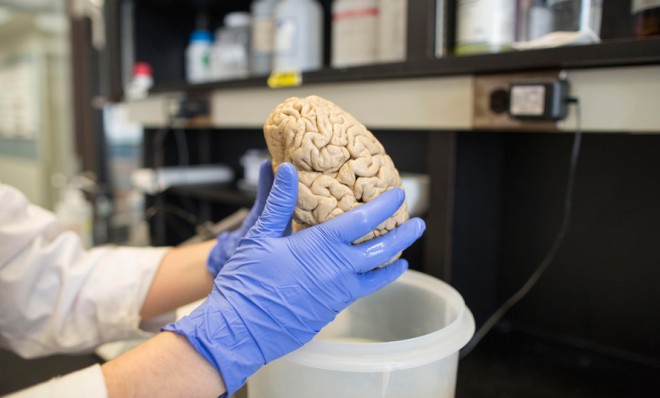These tiny brains were grown in a lab
Adorable! And also creepy.

The human brain is a spectacular supercomputer that lets us do all sorts of miraculous things, like reading the very words on this screen. So perhaps it shouldn't be a surprise that understanding all of its intricate neural circuitry has proven to be a massively difficult undertaking, which at least partly explains why the White House is cozying up with the scientific community and spending $100 million to map the human mind in its entirety.
A small team of researchers in Europe, meanwhile, are taking a somewhat different approach to understanding how the brain carries out its various functions. They're growing their own in a lab.
Neuroscience researchers at the Institute of Molecular Biotechnology of the Austrian Academy of Sciences have successfully cultivated tiny, pea-sized brains in a petri dish. The mini-minds boast roughly the cognitive capabilities of a nine-week-old fetus, but are — somewhat thankfully? — incapable of retaining thoughts or memories of their own.
The Week
Escape your echo chamber. Get the facts behind the news, plus analysis from multiple perspectives.

Sign up for The Week's Free Newsletters
From our morning news briefing to a weekly Good News Newsletter, get the best of The Week delivered directly to your inbox.
From our morning news briefing to a weekly Good News Newsletter, get the best of The Week delivered directly to your inbox.
So how do you grow itty, bitty brains out of living tissue in the first place? Since you can't just mosey over to the brain store and purchase a batch of wrinkled seedlings, you start with a gooey cocktail of embryonic or induced pluripotent stem cells, which have the miraculous ability to transform into just about any kind of living tissue. Here's LiveScience's detailed explanation of the brain-growing process:
[The research team] grew the cells in conditions that allowed them to form a tissue called neuroectoderm, which develops into the nervous system. The researchers embedded fragments of the tissue in droplets of gel to create a scaffold to guide further growth. They then transferred the droplets to a spinning bioreactor that increased nutrient absorption.
After 15 to 20 days, the tissue formed minibrains called cerebral organoids, each enclosing a fluid-filled region, much like the cerebral ventricles that contain cerebrospinal fluid in the human brain. After 20 to 30 days, some of the organoids formed defined brain areas, including a cerebral cortex (the brain's complex outer layer); retinal tissue, the light-sensitive part of the eye; meninges, the membranes that envelope the brain; and choroid plexus, which produces the cerebrospinal fluid that bathes the brain. [LiveScience]
These tiny, non-complex brains aren't intended to be transferred into scary mini-humans, and thankfully, they're about as large as they're ever going to grow. The basic idea behind their existence is this: Right now, neuroscience research hinges largely on the study of rodent brains. While the brains of rats and mice are perfectly fine and boast remarkable similarities to our own, they're still far from ideal. These lab-grown brains are better.
Researchers say they're using these lab-grown noggins to specifically study microcephaly, a neurodevelopmental disorder often caused by having an unusually small head. "Ultimately we would like to move towards more common disorders like schizophrenia or autism," researcher Dr. Juergen Knoblich told BBC News.
A free daily email with the biggest news stories of the day – and the best features from TheWeek.com
-
 Will Trump’s $12 billion bailout solve the farm crisis?
Will Trump’s $12 billion bailout solve the farm crisis?Today’s Big Question Agriculture sector says it wants trade, not aid
-
 ‘City leaders must recognize its residents as part of its lifeblood’
‘City leaders must recognize its residents as part of its lifeblood’Instant Opinion Opinion, comment and editorials of the day
-
 10 upcoming albums to stream during the winter chill
10 upcoming albums to stream during the winter chillThe Week Recommends As the calendar turns to 2026, check out some new music from your favorite artists